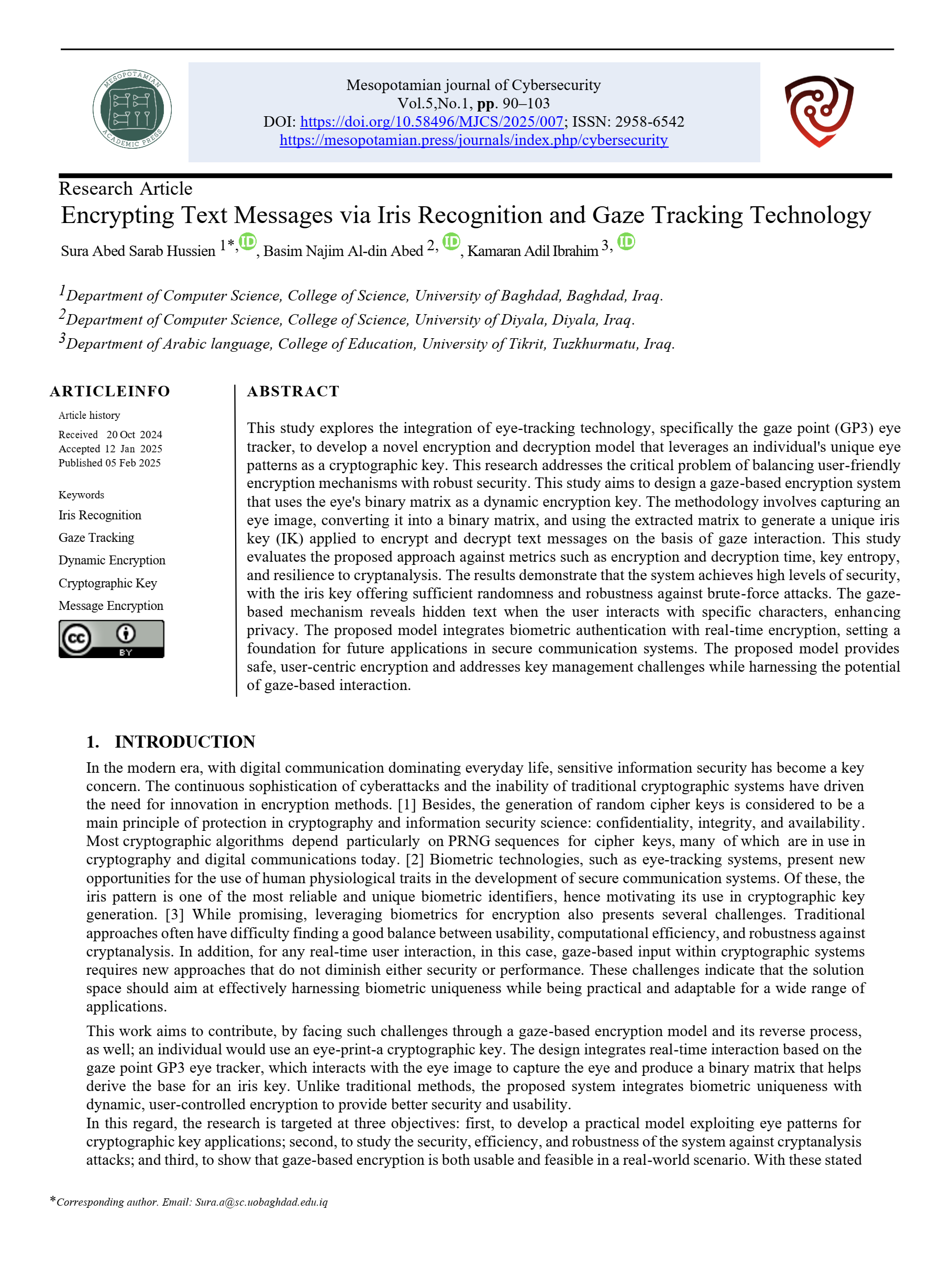Encrypting Text Messages via Iris Recognition and Gaze Tracking Technology
Main Article Content
Abstract
This study explores the integration of eye-tracking technology, specifically the gaze point (GP3) eye tracker, to develop a novel encryption and decryption model that leverages an individual's unique eye patterns as a cryptographic key. This research addresses the critical problem of balancing user-friendly encryption mechanisms with robust security. This study aims to design a gaze-based encryption system that uses the eye's binary matrix as a dynamic encryption key. The methodology involves capturing an eye image, converting it into a binary matrix, and using the extracted matrix to generate a unique iris key (IK) applied to encrypt and decrypt text messages on the basis of gaze interaction. This study evaluates the proposed approach against metrics such as encryption and decryption time, key entropy, and resilience to cryptanalysis. The results demonstrate that the system achieves high levels of security, with the iris key offering sufficient randomness and robustness against brute-force attacks. The gaze-based mechanism reveals hidden text when the user interacts with specific characters, enhancing privacy. The proposed model integrates biometric authentication with real-time encryption, setting a foundation for future applications in secure communication systems. The proposed model provides safe, user-centric encryption and addresses key management challenges while harnessing the potential of gaze-based interaction.
Article Details
Issue
Section

This work is licensed under a Creative Commons Attribution 4.0 International License.
How to Cite
References
[1] S.A.S. Hussien, T.A.S. Hussien, M.A. Noori, ”A Proposed Algorithm for Encrypted Data Hiding in Video Stream Based on Frame Random Distribution”, Iraqi Journal of Science, 2021, 62(9), pp. 3243–3254. DOI: 10.24996/ijs.2021.62.9.37.
[2] Nada Hussein M. Ali, Mays M. Hoobi, and Dunia F. Saffo, Development of Robust and Efficient Symmetric Random Keys Model based on the Latin Square Matrix, Mesopotamian journal of Cybersecurity, Vol.4, No.3, pp.203-215, 2024
[3] P. Mwiinga, “Privacy-Preserving Technologies: Balancing Security and User Privacy in the Digital Age,” International Journal of Scientific and Research Publications, Eden University, December 2023, DOI: 10.5281/zenodo.10406538.
[4] F. Hazzaa, M. Hasan, A. Qashou, S. Yousef, “A New Lightweight Cryptosystem for IoT in Smart City Environments,” Mesopotamian Journal of Cybersecurity, 4(3), 2024, 46–58. DOI: https://doi.org/10.58496/MJCS/2024/015.
[5] M.A.F. Al-Husainy, B. Al-Shargabi, S. Aljawarneh, “Lightweight cryptography system for IoT devices using DNA”, Computers & Electrical Engineering, October 2021, 95:107418. DOI: 10.1016/j.compeleceng.2021.107418.
[6] Holmqvist, K., Nyström, M., Andersson, R., Dewhurst, R., Jarodzka, H., and van de Weijer, J., “Eye tracking: A comprehensive guide to methods and measures,” Oxford University Press, 2011, DOI: https://www.researchgate.net/publication/254913339_Eye_Tracking/.
[7] Rathgeb, C., & Busch, C., “Cancelable multi-biometrics: Mixing iris-codes based on adaptive bloom filters,” Computers & Security, vol. 42, May 2014, PP. 1-12, Doi: https://doi.org/10.1016/j.cose.2013.12.005.
[8] George, A. and Routray, A., “Fast and accurate algorithm for eye localization for gaze tracking in low-resolution images,” IET Computer Vision, Volume 10, Issue 7, Oct 2016, Pages 613-767. Doi: https://doi.org/10.1049/iet-cvi.2015.0316.
[9] Duchowski, A. T., “Eye tracking methodology: Theory and practice,” Springer Science & Business Media, Vol. 373, 2017, DOI: 10.1007/978-1-84628-609-4.
[10] Li, X., Jiang, Y., Chen, M. et al., “Research on iris image encryption based on deep learning,” J Image Video Proc. 2018, 126 (2018), Doi: https://doi.org/10.1186/s13640-018-0358-7.
[11] M. Mehrubeoglu and V. Nguyen, "Real-time eye tracking for password authentication," 2018 IEEE International Conference on Consumer Electronics (ICCE), Las Vegas, NV, USA, 2018, pp. 1-4, Doi: 10.1109/ICCE.2018.8326302.
[12] J. Qi, G. Jiang, G. Li, Y. Sun, B. Tao, “Intelligent human-computer interaction based on surface EMG gesture recognition,” IEEE Access, May (2019), pp. 61378-61387, DOI: 10.1109/access.2019.2914728.
[13] Y.S. Pai, T. Dingler, K. Kunze, “Assessing hands-free interactions for VR using eye gaze and electromyography,” Virtual Reality, 23 (2) (2019), p. 119-131, DOI: 10.1007/s10055-018-0371-2.
[14] Mahmud S, Lin X, Kim JH., “Interface for human-machine interaction for assistant devices: a review,” In: 2020 10th annual computing and communication workshop and conference (CCWC), Jan. 2020, Doi: https://doi.org/10.1109/CCWC47524.2020.9031244.
[15] I. Rakhmatulin, A. T. Duchowski, “Deep Neural Networks for Low-Cost Eye Tracking,” Procedia Computer Science, Volume 176, 2020, PP. 685-694, DOI: https://doi.org/10.1016/j.procs.2020.09.041.
[16] H. Chen, M.C. Leu, Z. Yin, “Real-time multi-modal human-robot collaboration using gestures and speech,” J Manuf Sci Eng, 144 (10) (2022), https://doi.org/10.1115/1.4054297.
[17] P. H. Chena N. Zendehdela, M. C. Leua, Z. Yinb, “Real-Time Human-Computer Interaction Using Eye Gazes,”, 51st SME North American Manufacturing Research Conference, Volume 35, August 2023, pp. 883-894, Doi: https://doi.org/10.1016/j.mfglet.2023.07.024.
[18] H. Zhang, X. Li, S. -Y. Tan, M. J. Lee and Z. Jin, "Privacy-Preserving Biometric Authentication: Cryptanalysis and Countermeasures," in IEEE Transactions on Dependable and Secure Computing, vol. 20, no. 6, pp. 5056-5069, Nov.-Dec. 2023, Doi: 10.1109/TDSC.2023.3239611.
[19] S. Y. . Mohammed and M. . Aljanabi, “From Text to Threat Detection: The Power of NLP in Cybersecurity”, SHIFRA, vol. 2024, pp. 1–7, Jan. 2024, doi: 10.70470/SHIFRA/2024/001.
[20] Jain, A. K., & Kumar, A., “Biometric recognition: An overview,” Encyclopedia of Biometrics, 2nd Edition, 2012, pp. 1-12, http: JainKumar_BiometricsNextGeneration_Overview.pdf (msu.edu).
[21] Galbally, J., Marcel, S., & Fierrez, J., “Biometric antispoofing methods: A survey in face recognition,” IEEE Access, 2015, 2, pp. 1530-1552, 2014, Doi: https://doi.org/10.1109/ACCESS.2014.2381273.
[22] Pagnin E., Mitrokotsa A., “Privacy-Preserving Biometric Authentication: Challenges and Directions”, Security and Communication Networks,19 October 2017, DOI: https://doi.org/10.1155/2017/7129505
[23] M. Aljanabi , “Safeguarding Connected Health: Leveraging Trustworthy AI Techniques to Harden Intrusion Detection Systems Against Data Poisoning Threats in IoMT Environments”, BJIoT, vol. 2023, pp. 31–37, May 2023, doi: 10.58496/BJIoT/2023/005.




